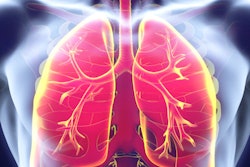
Using a risk-prediction model to determine eligibility for CT lung screening is more effective for detecting cancers than current guidelines from the U.S. Preventive Services Task Force (USPSTF), according to new results from the International Lung Screen Trial (ILST) presented at the recent World Conference on Lung Cancer in Barcelona, Spain.
"One of the key issues in lung cancer screening is, how do we identify people with sufficient risk who would benefit most from low-dose CT screening?" presenter Dr. Stephen Lam, from the University of British Columbia in Canada, told meeting attendees. The conference was hosted by the International Association for the Study of Lung Cancer (IASLC).
Currently, most CT lung cancer screening programs in the U.S. rely on variants of eligibility criteria from the National Lung Screening Trial (NLST) to decide whether an individual qualifies for CT lung screening. The USPSTF recommendations mirror the NLST criteria, relying on patient age and smoking history to determine eligibility.
However, these generalized guidelines could leave out many individuals who might benefit from the screening exam and, conversely, include those who could do without it, Lam noted.
In an effort to optimize the screening eligibility criteria, various groups have supported the use of risk-prediction models such as the Prostate, Lung, Colorectal, and Ovarian Cancer Screening Trial Model 2012 (PLCOM2012), which determines eligibility based on a collection of patient factors beyond age and smoking history. Several retrospective studies have shown that such risk models can more accurately identify patients who would benefit from CT lung screening and increase the exam's cost-effectiveness.
Seeking to further validate these findings, Lam and colleagues conducted an international, prospective study comparing the accuracy of the USPSTF and PLCOM2012 screening enrollment criteria. The study included 4,985 smokers from Canada, Australia, Hong Kong, and the U.K. who met either of the two screening criteria. Roughly 100 of the trial participants turned out to have lung cancer.
Overall, the risk-prediction model offered a significantly higher sensitivity and positive predictive value than the USPSTF criteria for detecting lung cancer throughout the study's six-year period, the researchers found. The optimal PLCOM2012 screening threshold was to include individuals who had at least a 1.7% risk of developing lung cancer within six years.
| USPSTF criteria vs. PLCOM2012 risk-prediction model for CT lung screening | ||
| USPSTF criteria | PLCOM2012 | |
| % of lung cancers detected | 77% | 99% |
In addition, about 80% of people who did not meet the USPSTF screening criteria but were at risk of developing lung cancer based on PLCOM2012 results turned out to have potentially curable early-stage lung cancer.
"Our analysis of ILST data indicates that classification accuracy of lung cancer screening outcomes supports the PLCOM2012 criteria over the USPSTF criteria," Lam concluded.




















